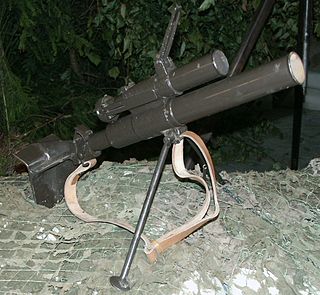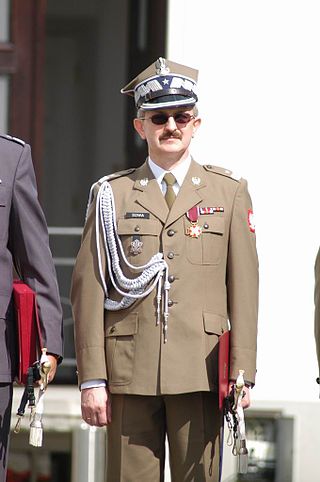
The karabin przeciwpancerny wz. 35 is a Polish 7.92 mm anti-tank rifle that was used by the Polish Armed Forces during the 1939 Polish Campaign of World War II and later by several Axis armies. It was designated wzór 35 for its design year, 1935. It was also known by its codename "Uruguay", after the country and by the name of its designer, Józef Maroszek.

The European Defence Agency (EDA) is an agency of the European Union (EU) that promotes and facilitates integration between member states within the EU's Common Security and Defence Policy (CSDP). The EDA is headed by the EU High Representative for Foreign Affairs and Security Policy, European Commission’s Vice President (HR/VP), and reports to the Council. The EDA was established on 12 July 2004 and is based in Brussels, Belgium, along with a number of other CSDP bodies.

Ckm wz. 30 is a Polish-made clone of the American Browning M1917 heavy machine gun. Produced with various modifications such as greater caliber, longer barrel and adjustable sighting device, it was an improved although unlicensed copy of its predecessor, and was the standard machine gun of the Polish Army from 1931.
The Karabin samopowtarzalny wzór 38M, was a prototype Polish 7.92mm semi-automatic rifle used by the Polish Army during the Invasion of Poland of 1939.

The P-64 is a Polish semi-automatic pistol designed to fire the 9×18mm Makarov cartridge. The pistol was developed in the late 1950s at the Institute for Artillery Research by a team consisting of: W. Czepukajtis, R. Zimny, H. Adamczyk, M. Adamczyk, S. Kaczmarski and J. Pyzel. The P-64 is also known as the CZAK.

Fabryka Broni "Łucznik" – Radom —also known as Fabryka Broni Radom or Zakłady Metalowe "Łucznik"—is a Polish defence industry enterprise from Radom that produces firearms. The enterprise is part of the Polska Grupa Zbrojeniowa SA.

The Defence Institute of Advanced Technology (DIAT) is the premier engineering training institute under the Department of Defence Research & Development, Ministry of Defence, and Government of India. DIAT (DU) provides higher education to civilians and officers from Defence Research Organizations, IOFS, Defence PSUs, ship building agencies, Mazagon Dock Shipbuilders, armed forces of friendly countries, and other central and state governmental agencies.

The 10TP was a Polish light cruiser tank that never progressed beyond the prototype stage. Though intended to contribute to the Polish armour development programme, the prototype was ultimately deemed unsuccessful. However, insights gained during testing informed the design of the subsequent 14TP model, which was never completed due to the outbreak of World War II.

The Granatnik wz.36 was a Polish grenade launcher designed in originally in 1927 as "wz. 30" and later modified in 1936. It entered service in 1936 becoming the standard grenade launcher of the Polish Army; it was still in use during the German Invasion of Poland in 1939.
The Swedish Defence Research Agency is a government agency in Sweden for total defence research and development.

Brigadier General (Ret) Adam Sowa was the deputy chief executive of the European Defence Agency. He served in Polish Army from 1975 and has held a range of appointments related to science and technology, armaments and defense industry, international co-operation, education and training and personnel policy both in Poland and abroad.

Military University of Technology is the civil-military technical academic institution in Poland, located at Bemowo, Warsaw. It was established in 1951. The university's rector-commander is Brig. Gen. Przemysław Wachulak. The university is supervised by the Minister of National Defence of Poland and conducts scientific research for the needs of Polish Armed Forces. Currently the university educates almost 10,000 students. The staff consists of about 1,000 employees, including 220 professors.

The Polska Grupa Zbrojeniowa or PGZ SA is a holding company established by the Polish government in 2013 to unite Polish state owned defence industry companies. Headquartered in Radom, the group is Poland's largest and one of Europe's major arms manufacturers comprising over 50 subsidiaries.

The Secretary of State for Defence (SEDEF) is the second-highest-ranking official in the Ministry of Defence of Spain. The SEDEF is a civilian which is appointed by the King with the advice of the Defence Minister. In spite of being the second authority of the Ministry, it is behind the Chief of the Defence Staff as far as military control is concerned.
In Turkey, Defence Industry Agency ; formerly Presidency of Defence Industries and Undersecretariat for Defence Industries (SSM) before that, is a civil institution established by the government to manage the Defence industry of Turkey and the supply of military technology. It was established under Law No. 3238 on 7 November 1985 under the name of "Defence Industry Development and Support Administration Office".

120×570mm NATO tank ammunition, also known as 120×570mmR, is a common, NATO-standard, tank gun semi-combustible cartridge used by 120mm smoothbore guns, superseding the earlier 105×617mmR cartridge used in NATO-standard rifled tank guns.

The CN08 is a 120 mm 55-caliber smoothbore tank gun produced by Hyundai WIA. It is incorrectly known as the licensed production of the Rheinmetall Rh-120 L/55, but it was indigenously developed by the Agency for Defense Development and WIA from 2003 to 2008 for the XK2 development project started in 1995. The development was completed after the field test ended in September 2008.















